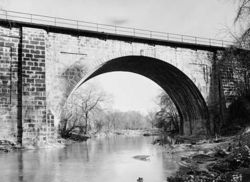Carrollton Viaduct
| Carrollton Viaduct | |
|---|---|
 Carrollton Viaduct in 1971 | |
| Carries | Two tracks of CSX Transportation |
| Crosses | Gwynn's Falls |
| Locale | Baltimore, Maryland |
| Maintained by | CSX Transportation |
| Design | Arch bridge |
| Longest span | 80 feet (24 m) |
| Total length | 312 feet (95 m) |
| Clearance below | 51 feet, 9 inches (15.8 m) |
| Opening date | 1829 |
| Carrollton Viaduct | |
|---|---|
| (U.S. National Historic Landmark) | |
| Location: | Baltimore, Maryland |
| Coordinates: | |
| Built/Founded: | 1828 |
| Architect: | James Lloyd; Caspar Wever |
| Added to NRHP: | November 11, 1971[1] |
| Reference #: | 71001032 |
| Governing body: | Private |
The Carrollton Viaduct, located over Gwynn's Falls near Carroll Park in Baltimore, Maryland, is the first stone masonry bridge built for railroad use in the United States. Today it is the world's oldest railway bridge still in use, carrying loads far greater than originally envisioned.[2] It was named after Charles Carroll of Carrollton, the last living signer of the Declaration of Independence (United States)|Declaration of Independence, who laid the cornerstone on July 4, 1828.[3] As he laid the first stone he said: "I consider this among the most important acts of my life, second only to my signing the Declaration of Independence." Builder Caspar Weaver and designer James Lloyd completed the structure for the Baltimore and Ohio Railroad in November 1829, at the cost of $58,106.73.
The bridge, 312 feet (95 m) in length, rises from its foundations about 65 feet (20 m). It is 51 feet, 9 inches (15.8 m) above Gwynn's Falls. It consists of a full-centered arch with a clear span length of 80 feet (24 m) over the stream, and a space for two railroad tracks on its deck. To provide an underpass for a wagon road, an arched passageway, 16 feet (5 m) in width, was built through one of the masonry-walled approaches. Originally planned as one arch of 40 feet (12 m) chord, the dimensions were enlarged to quiet the concern of the proprietor of the mills located immediately above the bridge site, who feared that 40 feet would be insufficient if the stream was flooded. The heavy granite blocks which form the arches and exterior walls were procured from Ellicott's Mills and Port Deposit. A temporary wooden framework supporting the central span held 1,500 tons (1,360 tonnes) of this stone during construction. A white cornerstone at one end of the bridge bears the inscription "James Lloyd of Maryland, Builder A.D. 1829."
Andrew Jackson, the first President of the United States to ride on a railroad train, crossed the bridge on a trip between Ellicott's Mills and Baltimore on June 6, 1833. The Carrollton Viaduct has provided continual service to the Baltimore and Ohio Railroad and its modern corporate successor, CSX Transportation.
The viaduct was designated a National Historic Landmark on November 11, 1971 and was automatically listed on the National Register of Historic Places the same day.[4][5]
In 1982 it was designated a Historic Civil Engineering Landmark by the American Society of Civil Engineers.
References and footnotes
- Cook, Richard J. (1987). The Beauty of Railroad Bridges in North America -- Then and Now. Golden West Books, California (USA). ISBN 0-87095-097-5.
- Historic American Engineering Record survey No. HAER MD,4-BALT, 129- "Significance" section.
- ↑ National Register Information System. National Register of Historic Places. National Park Service (2007-01-23).
- ↑ Johns Hopkins University, Department of Civil Engineering. Carrollton Viaduct. Retrieved on April 5, 2006.
- ↑ John Moody (1919). The Railroad Builders. Retrieved on April 6, 2006. (The HAER report states that the cornerstone was laid in May 1828.)
- ↑ Cite error: Invalid
<ref>tag; no text was provided for refs namednhlsum - ↑ W. Brown Morton III (August 5, 1971), National Register of Historic Places Inventory-Nomination: Carrollton ViaductPDF (282 KB), National Park Service. Accompanying 2 photos, from 1971.PDF (320 KB])
External links
- National Historic Landmark information
- National Register information
- NPS write-up
- American Society of Civil Engineers - Carrollton Viaduct
- Library of Congress HABS/HAER - Carrollton Viaduct
- Pages with reference errors
- National Historic Landmarks of the United States
- Deck arch bridges
- Bridges completed in 1829
- Bridges in Maryland
- Buildings and structures in Baltimore
- Railway bridges in the United States
- Registered Historic Places in Maryland
- Viaducts
- CSX Transportation bridges and tunnels
- Baltimore and Ohio Railroad bridges and tunnels
- Baltimore County, Maryland

